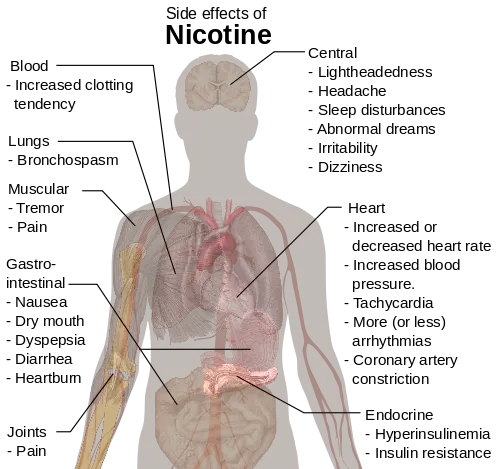 In a conventional society, there has never been any harm done to anybody when one derives pleasure while being with friends or loved ones, having his or her favorite steak or enjoying their favorite hobby. According to science, during such events, a neurotransmitter – dopamine is released in the brain. In the case of Nicotine, it causes the release of the same neurotransmitter, but the pleasurable feeling wears off quickly, tempting the user to get back the feel. And thus, the beginning of an addiction, which has deadly effects. Here are some facts that you should know about nicotine, it evolution and its harms.
In a conventional society, there has never been any harm done to anybody when one derives pleasure while being with friends or loved ones, having his or her favorite steak or enjoying their favorite hobby. According to science, during such events, a neurotransmitter – dopamine is released in the brain. In the case of Nicotine, it causes the release of the same neurotransmitter, but the pleasurable feeling wears off quickly, tempting the user to get back the feel. And thus, the beginning of an addiction, which has deadly effects. Here are some facts that you should know about nicotine, it evolution and its harms.
Fact 1: In his first visit to the New World, Christopher Columbus discovered tobacco when he landed in what is now the West Indies. After Columbus brought the plant back to Europe, the widespread cultivation and trade of tobacco began in earnest. For a time, Europeans too believed that tobacco had medicinal properties. In 1559, French ambassador Jean Nicot sent tobacco leaves from his post in Portugal to his friends in France, encouraging them to use tobacco to treat asthma and other illnesses. When French scientists isolated tobacco’s addictive chemical in 1828, they named it after Jean Nicto and called in Nicotine.
Fact 2: By the mid-seventies, tobacco and its products, especially cigarettes – seemed to be everywhere. It had become a ubiquitous and established part of American culture. So, when the US Surgeon General released a report, even on something as mundane as tobacco use, people stopped and listened. The first Surgeon General’s report on smoking was released in 1964 – on a Saturday, so as not to send the stock market into a tailspin – and it confirmed that tobacco use was hazardous to our health. All of a sudden, the country was shaken out of its hazy stupor. Although the report stopped short of calling nicotine an addictive drug, it pronounced a definite connection between smoking and lung cancer.
Fact 3: Nicotine in a cigarette does not cause cancer. Tar in the smoke causes it. But, Nicotine is an addictive drug and there are several other harmful chemicals in a cigarette that are dangerous.
Fact 4: Nicotine is also present in small amounts in tomato, potato, green pepper, eggplant and coca plants. Plants produce nicotine to protect themselves from predators, and people use nicotine in pesticides for the same reason.
Fact 5: Nicotine is extremely poisonous. Just 30 – 60 mg of nicotine (a drop of pure nicotine in liquid form) is a lethal dose for an average adult. That said, tobacco products do not contain enough nicotine to cause a fatal overdose when used as directed. For example, a typical manufactured cigarette contains about 10 mg of nicotine, but most of it goes up in smoke, with approximately one milligram of nicotine being inhaled by the smoker.
Fact 6: Nicotine can be lethal to children in doses as small as 10 milligrams. Nicotine is present in the residue left behind by cigarette smoke in a closed environment, also known as third-hand smoke. This presents a danger to small children.
Fact 7: An estimated 88 million nonsmoking Americans, including 54% of children aged 3–11 years, are exposed to secondhand smoke. Each year, primarily because of exposure to secondhand smoke, an estimated 3,000 nonsmoking Americans die of lung cancer.
Fact 8: Studies done by the US Department of Health and Human Resources and the Philip Morris tobacco company have shown that kids who have a parent who smokes is at least twice as likely to take up smoking. Having an older brother or sister who smokes makes a child three times as likely to start smoking. However, kids whose parents talk to them regularly about not smoking are less likely to smoke (even if their parents smoke)
Fact 9: Medications for quitting that have been found to be effective include Nicotine replacement products such as over-the-counter nicotine patch – which is also available by prescription, gum, lozenge, inhaler, nasal spray.
Fact 10: E-cigarettes have not been fully studied, so there is limited knowledge about it and its potential risks; even about how much nicotine or other potentially harmful chemicals are being inhaled during use, or whether there are any benefits associated with using these products.










Leave a Reply